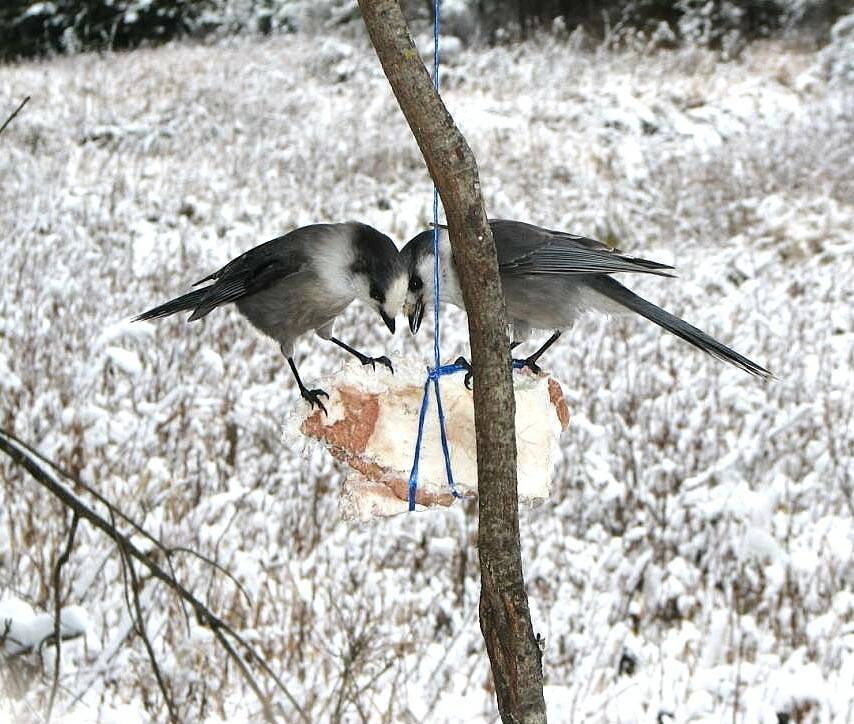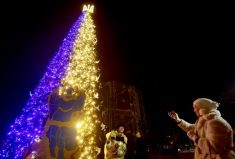With a cold spell, the Christmas season suddenly arrived at the Basswood School.
I was in Grade 2 in 1967 in that Manitoba hamlet. Like most of my peers, we talked about it, but really didn’t know what to do. However, our resourceful teacher came to the rescue.
Ms. Mandzuk had to handle both the Grade 1 and Grade 2 classes, which meant about 20 pupils. She had the classic 1960s look: tall, thin and with plenty of hair piled up. I don’t know where she came from or where she went off to when the Consolidated School closed forever in June 1969. But I do know she made Christmas more exciting and happy during those chilly December weeks for us farm children.
Read Also

Hunting with whiskey jacks
Canada jays, or whiskey jacks, are bold little deer hunting pals that don’t mind getting close, if it means a piece of the offal or deer fat left over from a successful forest hunt in Manitoba.
She may have been motivated by panic, which prompted her to come up with Christmas activity ideas. What to do with those students when it was too cold for them to go outside and play – and there are two recesses and a lunch hour to use up?
If left alone, quarrels would erupt over farm boy topics, such as whose dad has the biggest tractor or who had the best “stuck in the mud” story.
One day, after eating our lunches, we came back to the classroom and noticed the large windows covered with paper. And under the paper were outlines of Christmas scenes: reindeer, Christmas trees, manger settings, the three wise men, Santa and even Mrs. Claus.
Ms. Mandzuk had cut apart her Christmas activity book, taped the scenes to the windows and covered them with paper. With the winter sun backlighting the scenes, we could easily trace and then colour them. We grabbed our pencils. We got busy.
The windowsills were wide enough for us to kneel upon, but not too far off the floor to be dangerous. After the first group of 10 finished, she quickly replaced the covering paper and the next group began to trace.
Then the colouring started. We had no model to follow, nothing to suggest the shades of green or red, but that didn’t matter. If Santa’s suit turned out pinkish, we would just laugh. If the manger hay was blue-green, there must have been purple clover among it. Plus, if we had forgotten to trace part of the underlying image, no worries.
We were now pencil crayon and sketch artists, and we would use our “artistic licence” to fill in scenes in whichever way we thought proper.
Ms. Mandzuk asked that we take home our works to our families for decorating the farmhouse. Perhaps we’d also get a critique from older siblings – hopefully not too severe.
The next days were a blur of activity. We’d have to trace and colour all the scenes; we’d borrow and loan out our crayons and pencil crayons. We’d “ooh” and “aah” over the skills of others when they’d present a finished product. We traded them like hockey cards.
My buddy Wayne seemed to have unique waves among his colouring. He then showed me how to do a subtle over-lap to create that effect. Cool.
Ms. Mandzuk ran out and found more paper. Her idea had caught on and was the rage (or was that “craze” or “fad”?) for two weeks. We loved it. Who wants to play in the freezing cold anyway?
However, she went even further. She found red and green construction paper, scissors and glue in a dabber bottle. She cut the paper in strips of about an inch wide and eight inches long. She then glued the ends together to form a loop. In short order and with alternating colours, she had a festive “chain” four feet long. Let the production begin.
The glue had hardly dried when classmates began to decorate their desks, hanging the chains on the front. Then, with permission and a stepladder, we hung them along the tops of blackboards, doorways, window frames and along the hallways.
We boys grabbed a chain piece and tied up my classmate Andy. He broke free. It was worth a laugh.
Ms. Mandzuk said we could make our own at home, simply by slicing up and looping the paper from magazine ads. Christmas catalogues worked well too. What? To cut up the Sear’s Christmas Wishbook would be a crime! However, nothing could stop us. And why stick to just green and red?
We left behind a mess on the classroom floor. I do remember our teacher sweeping up at the end of the day. It must have been the trade-off to keep us occupied and happy. She had no qualms about it – or at least she didn’t state them.
It all came to an abrupt halt when we found out that Christmas holidays would begin tomorrow, and school would be out for two weeks. That announcement saddened us. We were having fun. Ms. Mandzuk said we could continue when we got back in January.
However, upon our return, the allure had disappeared. The decorations looked old, and maybe amateur, compared to the shiny tinsel and bright lights we had seen elsewhere during Christmas time. A few glued connections had come undone and the chains hung broken. It wasn’t pretty anymore.
We moved on to other things, like mild homework assignments given to second graders. The academic three R’s were a high priority in January.
Plus, those grade school crazes come and go quickly. I recall playing marbles in the schoolyard as a month-long obsession, and then nobody seemed to care. And in June we used tall grass and tree branches to build forts among the perimeter trees, but that soon lost its attraction. Too much fighting among warring forts, and too much work!
However, in those days of our youth and in the years of our childhood, the basic Christmas crafts learned in December 1967 live on. We still occasionally practice or teach them. I remember the joy it brought – and can still bring.















